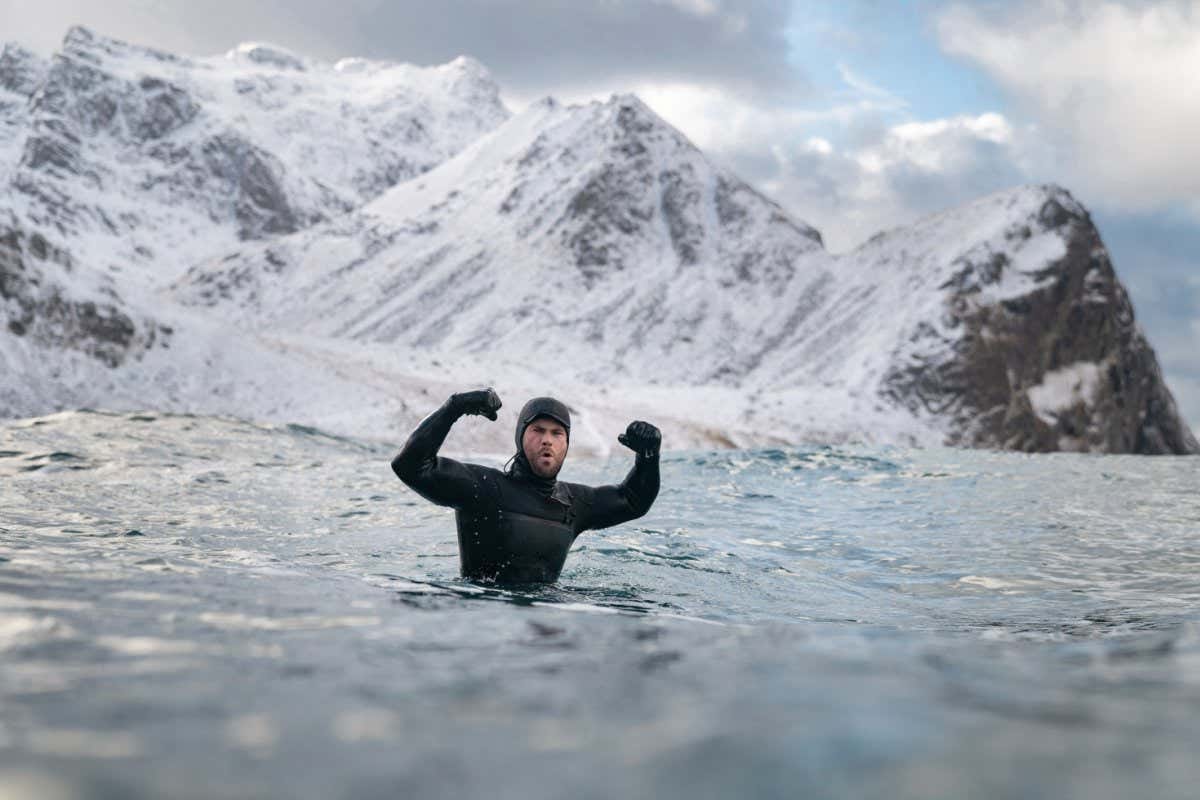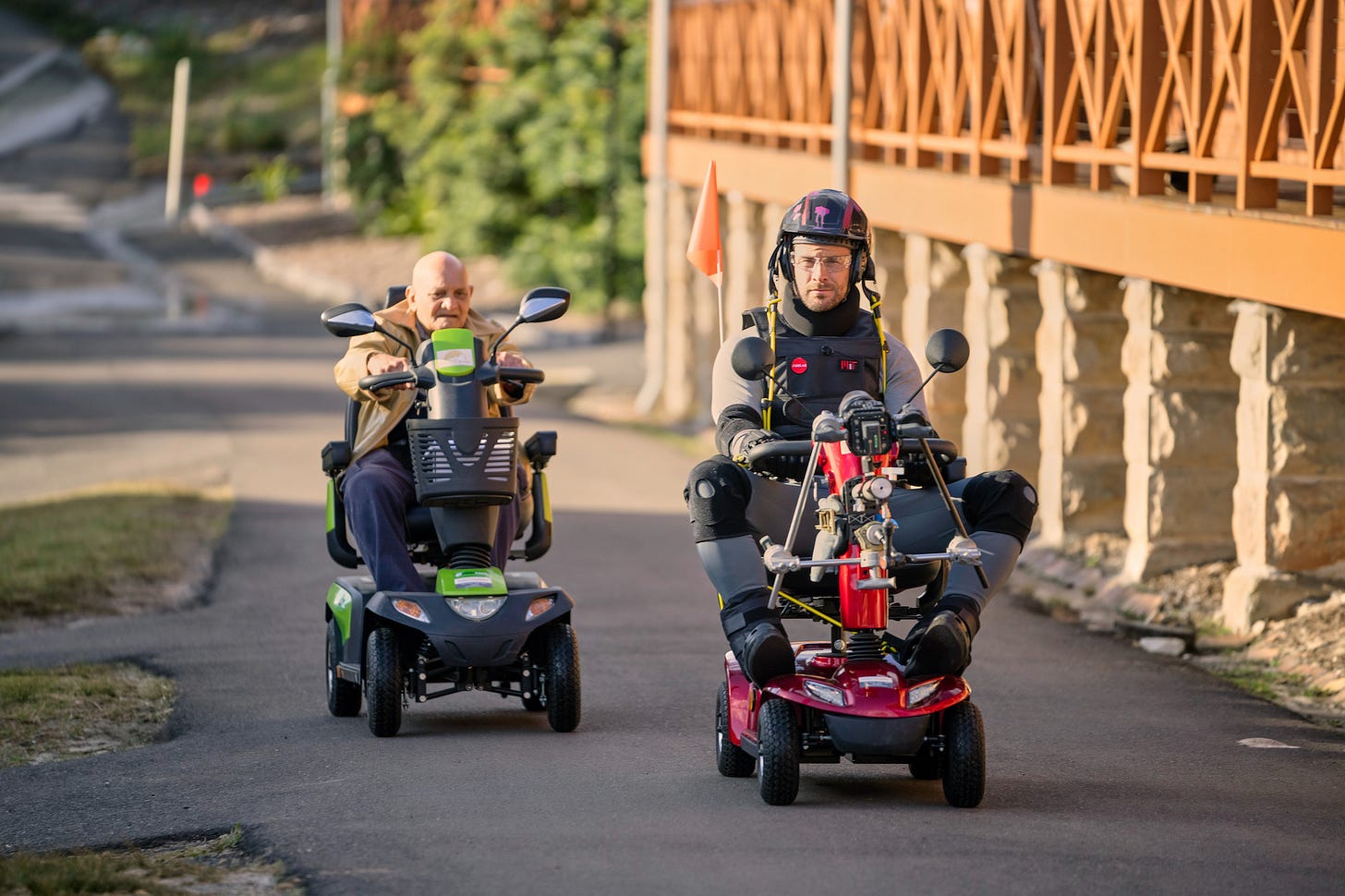#34: Acceptance is just the beginning.
The powerful first step to rebuilding after losing so much (featuring Chris Hemsworth).
Free & paid subscribers receive the exact same weekly content in their inboxes every Saturday morning. (The newsletter, vulnerable, personal, embarrassing stories, book recommendations, and whatever gifs have made me giggle.)
Considering upgrading to help myself and my editor Leona dedicate more time to The Luminist and support our current non-profit of choice: Experience Camps for grieving kids.
“Welcome to Sunset Pines, where we live every day to the fullest!”
His ice-blue eyes and broad cheekbones hidden under a globulous helmet and sight-reducing glasses, Chris Hemsworth squints at the pretend staff members of the pretend retirement village as they repeat this mantra… unfailingly, unendingly, annoyingly.
Personally, I think watching Hemsworth read a phonebook is a worthwhile endeavor. But his mini-series Limitless had me expanding my beefcake ideas (and fantasies) about Thor. Throughout the six episodes, he gamely plays giant, muscled guinea pig to help the viewer understand how we can expand and even overcome our limits. But also, which limits of the human experience cannot be conquered…
Episodes 1-5 are in-depth explorations of ways to be healthier — stress-proofing, cold-plunging, fasting, strengthening, memory enhancement, and more. The show’s vibe is both silly and scientific, offering Hemsworth as experimental sacrifice to the leading experts of ways to “live better for longer.” Through his triumphs and frustrations, epiphanies and re-starts (plus a whole lot of self-deprecation in that smoky Australian accent), Hemsworth aims to evolve viewers’ mindsets and behaviors for the sake of improving our healthspan, not merely our lifespan.
The final episode is different — very different.
Instead of surfing around icebergs or pulling golf carts with a body harness, you find Hemsworth in a retirement home called Sunset Pines, surrounded by genuine, wise, and wizened oldsters.
Chris is walked through three days of immersive senior experience by BJ Miller, a renowned palliative care doctor and author of A Beginner’s Guide to the End: Practical Advice for Living Life and Facing Death. Miller is the soulful, calm, patient yin to Chris’s understandable yang during his first day of the experiment… You’d be frustrated too if you suddenly found yourself stuffed into a restrictive cyborg suit designed to make you feel like you were 87 years old.
Miller shines in helping us understand the physical reality of human limitation — along with the cycles of denial, adaptation, and acceptance that turn these limitations into profound lessons. But the real stars of the episode are the real people who share their real stories of accepting what they cannot change and learning to love life anyway — in a new way, and sometimes even a deeper way.
For example, Chris faces off with oldster Gary during a pingpong match, where Gary summarily kicks his ass. The age suit limits Chris’s movements to the point that he can barely hit one return. The games ends with Chris grumbling, “Shut up, Gary” in response to Gary’s good-natured ribbing and throwing his paddle down in disgust.
BJ then finds Chris in a corner, sans bowling-ball helmet. As they talk about Chris’s frustrations, BJ invites Gary in to tell his own personal story.
A montage of Gary’s Kung Fu prowess in his younger years follows — his triumphs, his rewards, his pride in the strength and grace of his body. Gary then shares the grief of losing his martial artist identity through age and injury… Until he came across Tai Chi, which re-opened his world. He goes on to explain how this unexpected turn of events helped him to find “a new way of connecting to [his] physicality,” which translated to a new way of looking at himself and at life in general.
What started as a limitation became a revelation for Gary. Life was somehow bigger and vaster and more gratifying than he had previously imagined when everything was easy. The challenge had forced him beyond his comfort zone… and it turns out, there was a whole wide world of self-knowledge, self-acceptance, and self-love out there.
In Gary’s own words, “Once you learn to accept a thing for what it is, you find something even deeper and more valuable.”
Miller chimes in, “Even as our body is maybe weakening, it’s opening up something else… A part of us is getting smaller, but there’s this room for us to get bigger in some other way. And that’s when humans really shine, when we come up against a limit. It’s a gift in a way.”
And it all starts with what often is thought of as the last step — acceptance.
We talk a lot here at TL about action —
being empowered, engaged, and participatory in creating our technicolor lives. Action verbs galore.
But living through our suffering, our failures, our losses does not only involve action. In our most fragile times, we are probably not, ‘punching above our weight’, ‘taking the bull by the horns’, or ‘leaning in.’
In fact, sometimes we need to go into full-on hibernation.
But while it may not look like there is a lot happening on the surface, there’s a deep alchemical process taking place inside of anyone who has just come face-to-face with the “unfixable” — acceptance.
But what really is acceptance? And how does one reach it? Surrender to it? Fall backwards into it?
At the core of acceptance is releasing the idea of who we thought we were and what our lives were going to look like… which is unbelievably hard. Because we get attached to the parts of ourselves and our lives we believe we’ve worked hard for, are maybe even “owed” to us. We have an idea of the way things ought to be.
But on the other side of our ideas about what should happen is an endless buffet of possibility.
It’s not our limits that limit us.
It’s our ideas about what is right and wrong, good and bad, fair and unfair — for the external world, but also ourselves. We put ourselves into boxes about what we should do and want. Until life turns all that upside-down and it’s no longer up to us to choose. Life has forced us down a path we never wanted or imagined. There’s no changing it. Only reimagining ourselves inside this new story. Rewriting our character arc. Letting our very beings become the fertile ground of possibility.
Because freedom and opportunity are nothing if we ourselves are afraid to change, to try, to learn. Nothing wild and wonderful will happen until we are wild enough to say “YOLO” and see what happens.
Or in the case of myself and BJ Miller, until we don’t have any other option.
Miller lost three of his limbs at 19 in a freak accident. His identity as a vital, athletic, unstoppable young man collapsed, along with the dreams for his future… until he stopped asking his body or the world to change and allowed himself to change:
“My sense of self expanded to the point where I could not only accommodate limb loss, but I started making meaning and sense of my experience — I went into medicine. I fell immediately in love with palliative care… and now my job is to treat suffering and help others find meaning in their lives as well.”
Now, if that isn’t inspiring, I don’t know what is.
Before Mike died, I assumed people were grateful
because their lives were full of good things. But every day it becomes clearer and clearer that gratitude is a choice no matter the cowpies life has thrown in our way.
This feels dangerously close to toxic positivity, which is probably why it’s taken me so long to hop aboard the daily-gratitude-journal train. But I’m learning that gratitude does not require minimizing or denying the undeniable struggle-fest that is sometimes life. In fact, it’s helpful if we acknowledge it! And keep moving.
Acceptance helps us find the middle way through the pitfalls on either side of the spectrum — “this isn’t happening” or “this is terrible and I’ll never recover”. When we let either of these extremes dominate our mental landscape, we end up spending all our energy fighting the struggles and the suffering. In these mindsets, there is simply no room for appreciating the silver linings or even the full-blown blue bird days. Acceptance makes that room.
As Miller explains, “We tend to treat life as this right that we have — that by virtue of being born, we have a right to life, we have a right to a tomorrow. No. Life is a gift. Another day is a gift. A full life is one that includes death, includes pain, but if we [could still] be grateful for yet another minute on this beautiful, crazy planet… Imagine that!”
Hemsworth comes to the same conclusion, turning his baby-blues on the camera one last time to summarize his biggest take-away from Sunset Pines, “The truth is that we are not limitless. What matters? It all matters. Every moment, every smile, every tear, every kiss… All of it.”
Amen to that, brother.
Acceptance is not an abandonment of the good fight
to live your very best life. It is actually opening yourself to it — especially when “your very best life” no longer looks the way you had expected it to.
In the early days of my widowhood, I would scream at the sky, “You can come back now!!!” hoping to reach Mike, reach God, reach someone who could turn this terrible bus around.
Unsurprisingly, I did not.
Eventually, I got tired of yelling at something that could not or would not answer my pleas. I started looking around for things that could comfort me. And I found friends, family, books, baby leaves, big trees, sunrises, surprisingly deep work community. I stopped asking for something I could never have ever again, and instead decided — consciously decided — to release my identity as Mike’s wife. To accept that I was a single mom. To allow myself to love and be loved in previously unimagined ways.
Six years later, the new light of my life, The Luminist, was born. Not despite my loss, but because of it.
If I had stayed screaming at the sky, I never would have let nature, friends and family, meaningful work rush in to fill the void. It would have stayed a void, full of nothing but pain.
In this way, acceptance turns an ending into a beginning.
As the old adage goes, it’s not what you have, it’s how you use it.
To your unimagined futures, identities, possibilities,
Sue











Thank you for this thoughtful writing. It was just what I needed to read today. ❤️
In Buddhism, there is the practice on non-attachment, and that would spark emotional debates when it was taught. "Are you saying I shouldn't be attached to my spouse/children/family/loved ones?!" It's amazing how semantics can unravel people. Lesson One: Don't be attached to your idea of what the word attachment means. Non-attachment is just constant acceptance of what something/someone is, which is constantly changing. Not being attached to an outcome. Not being attached to who you think someone is, or the meaning they must have being in your life. Non-attachment is accepting things as they are and as they change. Acceptance isn't giving up or giving in. As much as I used to loathe "it is what it is," that is some gold. We have to learn when to let go and accept. You shouldn't hold on to something that could hurl you into a brick wall or drag you to the bottom of the well. Another wonderful post, Sue. Limits really are opportunities to open up to something new...which might actually be wonderful. xo